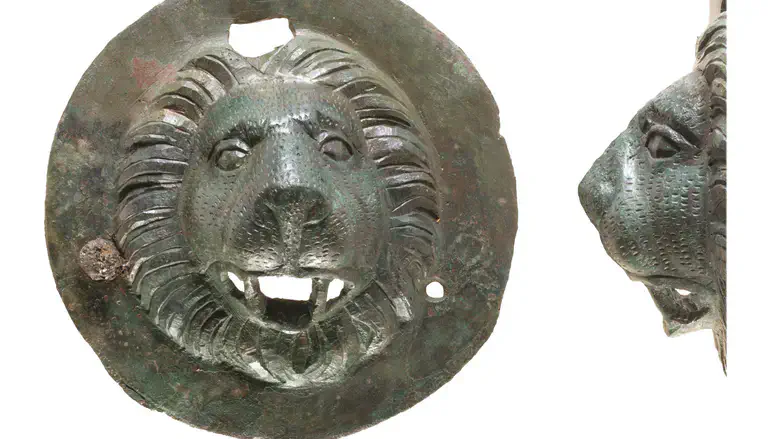
A singular discovery - four rare bronze discs, designed in the form of lion heads, about 1,900 years old and dated to the Roman era - the 1st-2nd centuries CE - were just published for the first time in the official Israel Antiquities Authority journal 'Atiqot, No. 117.
These ornamental discs were probably intended to enhance carrying handles for a coffin. Found in a 2018 salvage excavation at the Eyal interchange in the Sharon region, conducted by the Israel Antiquities Authority in Khirbat Ibreika, they were lying in an orderly pile inside a grave, seemingly where once a wooden coffin stood - which was not preserved.
According to Excavation Managers Dr. Elie Haddad and Elisheva Zwiebel, directors of the excavation on behalf of the Israel Antiquities Authority and authors of the article, “This is a unique and rare set of finds: the carrying handle ring, which was attached — in most of the known examples from the Roman world, through the lion's mouth — was joined in this case precisely to the disc’s vertex, at the top of the lion’s head. It seems this enabled freer and wider movement of the handles that served to lift the coffin and integrate it into a burial procession, while passing bars through the rings to better handle its transport.”
The unearthed lion heads are not identical to each other. Each face has a different expression, and each bears a different design of mane, eyes and nose.
“Similar discs were discovered in several other places in Israel, such as in Netanya and Tel Dor - most of them found in a distinct burial context,” the researchers note.
This discovery raises questions about the deceased’s identity and his ethnic and religious affiliation.
“Tracing the lion as symbol in the ancient world reveals that in many cultures it represented strength, protection and nobility,“ explain Dr. Haddad and Zwiebel. “At this stage we do not have enough evidence to associate the lions to a particular religion. However - the reasonable assumption is that here we have a pagan burial. In any case, these fancy, elaborate discs clearly reflect this individual’s high status.”
According to Eli Escusido, director of the Israel Antiquities Authority, “For thousands of years lions have symbolized bravery and courage. It is not by chance that the State of Israel‘s current campaign to neutralize the nuclear threat in Iran is called ‘A nation will arise like a lion’ - a phrase taken from the Bible (Numbers 23:24). Interestingly, similar rare discs were transferred about two years ago to the Israel Antiquities Authority as part of our antiquities repatriation program. At that time, a citizen who had such ancient lion objects just sitting in her living room contacted us, and requested to hand them over to Israel’s National Treasure collections. Thanks to this action, the lovely decorated discs were put into special climate conditions, which will preserve them for future generations to enjoy.”
Minister Amichai Eliyahu notes: “The discovery of the lion plaques offers us a compelling historical lesson. Although these are pagan artifacts, they reflect a recurring phenomenon throughout history: foreign cultures adopting ancient Jewish symbols. In the ancient world, the lion was not merely a decorative motif. It was, first and foremost, the emblem of the Tribe of Judah — ‘Judah is a lion’s whelp.’”
“Pagan cultures that once inhabited this land recognized the power of Jewish symbolism and were influenced by it, even if they did not always acknowledge it. This is a phenomenon we observe throughout history: The world is shaped by Jewish values, symbols, and heritage — sometimes even unknowingly. Western civilization as a whole is founded upon values rooted in the Bible and Jewish tradition.”




